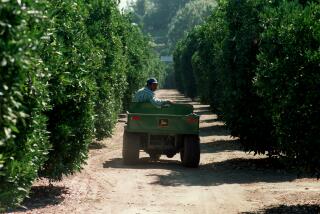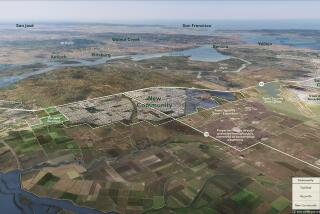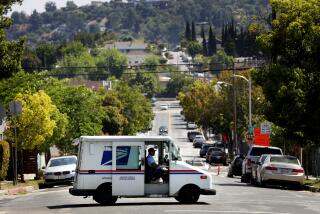Norco’s Growth Bid Puts Its Rural Life On the Line
- Share via
NORCO, Calif. — When Richard MacGregor went horseback riding 25 years ago, it was beside the oil wells that proliferated along riding trails in Huntington Beach.
But by 1970, Huntington Beach had become so urbanized that city officials were forced to ban horseback riding on city streets, prompting MacGregor to pack and move to Norco, a small town in western Riverside County that bore the motto “City Living in a Rural Atmosphere.”
Much to the relief of MacGregor, now a Norco councilman, his adopted hometown makes the same boast 20 years later. The city, with just over 25,000 residents, has fought off massive residential development--unlike Corona, its neighbor to the south, where neighborhoods dot the hillsides.
“There aren’t very many cities like this,” MacGregor said.
But restraints on residential development came at the expense of the city’s property tax base, forcing officials to search for new revenue sources.
For the past six years, in what some say is an ironic situation, city officials have tried to lure commercial development that will provide a sales tax base. The new money will enable Norco to maintain its riding trails and western motif, as well as its police and fire protection.
But some longtime residents fear that the city’s drive for commercial development is going too fast, and that traffic and other growth problems will destroy the city’s rural lifestyle. Others argue that commercial development has put the city in serious debt.
“Our community is being bombarded by development,” Mayor John Cobbe said last week. “It’s not easy. We cannot deny a developer the right to develop, but we have guidelines he has to go by.”
On Hamner Avenue and 6th Street, Norco’s two main commercial corridors, about half a dozen small strip malls have been built in the past five years. The Norco Auto Mall, opened in 1986 on Hamner, has four dealers so far with a fifth on the way, although it still has spaces for 11 dealerships.
This growth, city officials say, has helped Norco get itself back on its feet. This year, the city will take an estimated $1.4 million in sales tax revenue, up from $978,000 in 1988 and $589,000 in 1987. The new development has helped the city reopen a once-closed fire station, maintain city parks and renovate its 80 miles of horse trails, something almost unthinkable in the early 1980s when the city government had almost no money.
The city has also earmarked between $100,000 and $150,000 for horse-trail improvements this year, including the installation of a special stoplight at Hamner and 6th for horseback riders, said A.J. Wilson, the interim city manager.
The city now is negotiating with a developer and property owner for a 55-acre retail development on 2nd Street at the south end of town, Wilson said. Such a development, targeted for completion in late 1991 or 1992, could increase sales tax revenue as much as 200%, he said.
Norco’s salvation, Wilson said, was the completion of Interstate 15 through the city in June, 1989. He said that the freeway, more than anything, contributed to the city’s ability to attract businesses along Hamner Avenue, which runs parallel to the freeway.
This has also enabled Norco to stem the tide of its residents going to nearby cities for shopping and entertainment, he said.
“People will be able to keep their money at home in Norco and maintain their rural lifestyle,” Wilson said.
But many old-time residents, some of whom have lived in the city since the 1940s, question the need for such growth.
“It’s terrible,” said Phyllis Vaughan, 59, who moved to the community with her husband, Bill, in 1961. “It’s not Norco anymore.”
Where once Hamner Avenue had chicken farms, Vaughan said, it now has shopping malls and business parks. Such suburban growth, she said, has changed Norco’s character.
“I realize it’s progress,” Vaughan said, “but there isn’t much left that doesn’t have something on it.
“I hate to see it go,” she said. “What are my grand-kids going to do? Where will the open space be?”
Genevieve Taylor, 74, the president of the Norco Historical Society, said the city is trying to do too much too fast.
“They’re creating a lifestyle that is too expensive for what Norco is,” said Taylor, who moved to the city in 1950. “They’re trying to convince people that they need this commercial development to support the rural lifestyle. I don’t think there will ever be that many people (to support commercial development). I think eventually Norco will be a ghost town.”
Taylor’s husband, Red, helped incorporate Norco in 1964. Its name comes from North Corona, as it was originally called.
Others say that the city has landed in debt. Councilman Steve Nathan said that the city issued $22 million in redevelopment bonds last year, and it will take $60 million to pay them off. He pointed to the auto mall, which he said has fallen below expectations. One dealer has already gone out of business.
“We’re borrowing too much money to pay our bills,” Nathan said. “Everybody’s trying to get a shopping center. Everybody’s trying to get an auto mall.
“How much money are you going to spend. Where’s it going to stop?”
But city consultants say that there is still room for expansion with the opening of Interstate 15, said James Daniels, the city’s community development director.
City officials also say that fears about commercial growth getting out of hand are exaggerated. Wilson stressed that Norco has the unique situation of its commercial zone being isolated from major residential areas and parks. Many houses are out of view of new convenience stores and fast-food restaurants.
“In a crazy kind of way, you kind of end up with an automatic planning device,” he said.
The rural and commercial mix pleases some new residents--many of whom came to Norco from Orange County for affordable housing. Kevin M. Leary, a sales representative for Country Trails, a housing development on the northwest side of the city, in the Beacon Hill area, said that he even tells prospective buyers that in Norco they will be able to ride their horses to fast-food restaurants.
“I like the openness, I like the big lots,” said Jaynie Fernandes, 50, who moved to Norco four years ago.
The new stores “are all in the commercial area,” she added. “I just hope they put in a Penguin’s yogurt.”
When it comes down to it, city officials say, they don’t have too many other choices. Because of an ordinance banning housing units on lots smaller than half an acre, residential development has nearly reached capacity, and about 85% of residential land already is filled. The city’s population can’t grow much beyond 30,000, Wilson said. That makes it unfeasible to count on future property tax revenue.
Wilson predicted that in a decade, Norco will be at maximum density. But he said he is confident that even then, the city will be unique.
“Norco will probably end up being an island in the middle of an urban sprawl,” Wilson said. “If they can pull it off, 10 years from now they’re going to find this one of the best communities in Southern California.”
More to Read
Inside the business of entertainment
The Wide Shot brings you news, analysis and insights on everything from streaming wars to production — and what it all means for the future.
You may occasionally receive promotional content from the Los Angeles Times.










